#American Gas Association
Text
SoCal Gas spent millions on astroturf ops to fight climate rules

Today (19 Aug), I'm appearing at the San Diego Union-Tribune Festival of Books. I'm on a 2:30PM panel called "Return From Retirement," followed by a signing:
https://www.sandiegouniontribune.com/festivalofbooks

It's a breathtaking fraud: SoCal Gas, the largest gas company in America, spent millions secretly paying people to oppose California environmental regulations, then illegally stuck its customers with the bill. We Californians were forced to pay to lobby against our own survival:
https://www.sacbee.com/news/politics-government/capitol-alert/article277266828.html
The criminal scheme is spelled out in eye-watering detail in a superb investigative report by Joe Rubin and Ari Plachta for the Sacramento Bee, which names the law firms and individual lawyers involved in the scam.
Here's the situation: SoCal Gas is California's private, regulated gas monopoly. They are allowed to lobby, but are legally required to charge their lobbying activities to their shareholders, and are prohibited from raising customer rates to pay for lobbying.
The company spent years secretly violating this rule, in the sleaziest way possible: working with corporate cartels like the California Restaurant Association and BizFed, the monopoly paid BigLaw white-shoe firms to procure people who posed as concerned citizens in order to oppose climate regulations that are essential to the state's very survival.
The bill topped $36 million – and it was illegally charged to its customers, the Californians whose immediate health and long-term survival these efforts opposed. SoCal Gas refuses to disclose the full extent of the spending, as do its lawyer-procurers, who cite legal confidentiality and a First Amendment right to secretly seek to influence policy in their refusal to disclose their profits from this illegal conduct.
The law firms involved are a who's-who of California's most prominent corporate fixers, including Reichman Jorgensen and Holland & Knight. The partners involved have a long rap sheet for anti-climate dirty tricking, most notably Jennifer Hernandez, notorious in climate justice history for an incident where activists claim she posed as one of them, infiltrating a campaign to force corporate despoilers to clean up their pollution in order to sabotage it, while secretly on a wealthy, prominent landowner's payroll.
Hernandez claims to care about the environment and says that her longstanding, corporate-funded, extensive campaigns and lawsuits against state environmental regulations are motivated by concern over their impact on working people. Her firm, Holland & Knight, denies serving SoCal Gas in opposing gas regulations, but it received $594k in ratepayer dollars, and submitted comments opposing the rules on its own behalf. Those comments were nearly identical to the comments submitted by SoCal Gas.
Hernandez also represents an obscure organization called The Two Hundred for Home Ownership in "a flurry of lawsuits" over California Air Resources Board rules on pollution, seeking to overturn the state's landmark climate change regulations.
Two Hundred for Home Ownership was founded by Robert Apodaca, who told the Bee that Hernandez's work for him is pro bono and not funded by SoCal Gas, but his entry into the fray occurred just as SoCalGas was founding an astroturf group called Californians for Fair and Balanced Energy (C4BES), which pretended to be an independent organization, disguising its relationship with SoCal Gas.
Apodaca is also founder of United Latinos Vote, an organization that had been largely dormant for seven years, not receiving any donations, until 2018, when the California Building Industry Association gave it $99k. The CBIA is a large-dollar recipient of donations from SoCal Gas, and its CEO insists that it was not acting on SoCal Gas's behalf when it made its unpredented donation to Apodaca.
The CBIA donation to United Latinos Vote was forerunner to a flood of corporate donations from the likes of Chevron, Marathon and Phillips 66. Shortly after receiving this cash, United Latinos Vote ran a full page ad in the LA Times, accusing the Sierra Club of pushing for anti-gas appliance rules that would harm working class Latino families.
This ad, in turn, featured prominently in advocacy by the SoCal Gas front group C4BES, funded with $29.1m in ratepayer money, which it then spent seeking to link clean appliance rules with anti-Latino racism. A quarter of California's carbon emissions come from home gas use.
SoCal Gas is regulated by the California Public Utility Commission (CPUC), which tolerated this mounting illegal conduct for many years, even as the company circulated internal memos as early as 2015 discussing its plans to oppose electrification in the state on the basis that it constituted "a significant risk to our business."
But last year, CPUC fined SoCal Gas $10m. Now, CPUC's Public Advocate office has filed a damning, extensive report on SoCal Gas's unlawful conduct, seeking $80m in rate cuts to compensate Californians for the funds misappropriated to protect the company's shareholder interests:
https://docs.cpuc.ca.gov/PublishedDocs/Efile/G000/M517/K407/517407314.PDF
Additionally, the Public Advocate is demanding $233m in fines for the company's refusal to allow investigators to audit its books and discover the full extent of the fraud.
SoCal Gas is the nation's largest utility, but (incredibly), it's not the dirtiest. That prize goes to Ohio's FirstEnergy, which handed $60m in ratepayer dollars to state politicians in illegal bribes in exchange for coal and nuclear subsidies and cancellation of state climate rules. That scandal led to GOP speaker of the Ohio House Larry Householder being sentenced to 20 years in prison:
https://en.wikipedia.org/wiki/Ohio_nuclear_bribery_scandal
There is something extraordinarily sleazy about using ratepayers' own money to lobby against their interests. SoCal Gas and its Big Law enablers have funneled millions in Californian's money into campaigns to poison us and boil us alive, and they did it while using workers and racialized people as human shields.


I'm kickstarting the audiobook for "The Internet Con: How To Seize the Means of Computation," a Big Tech disassembly manual to disenshittify the web and make a new, good internet to succeed the old, good internet. It's a DRM-free book, which means Audible won't carry it, so this crowdfunder is essential. Back now to get the audio, Verso hardcover and ebook:
http://seizethemeansofcomputation.org

If you'd like an essay-formatted version of this post to read or share, here's a link to it on pluralistic.net, my surveillance-free, ad-free, tracker-free blog:
https://pluralistic.net/2023/08/19/cooking-the-books-with-gas/#reichman-jorgensen

Image:
Maryland GovPics (modified)
https://www.flickr.com/photos/mdgovpics/6635539089/
Jackie (modified)
https://www.flickr.com/photos/79874304@N00/197532792
CC BY 2.0
https://creativecommons.org/licenses/by/2.0/
#pluralistic#socal gas#california#climate emergency#climate denial#Reichman Jorgensen#california restaurant association#astroturf#Holland and Knight#puc#cpuc#california public utility company#fraud#Alice Walton#bribery#ohio#bizfed#Jennifer Hernandez#American Gas Association#The Two Hundred for Home Ownership#Robert Apodaca#Californians for Fair and Balanced Energy#C4BES#United Latinos Vote#Chevron#Marathon#Phillips 66#sacramento bee#sacbee#Joe Rubin
4K notes
·
View notes
Text
Antique Tractor Calendar 2024
Are you ready to start planning for the 2024 Antique Tractor shows, drives and farm toy shows? If so, here is my 2024 Antique Tractor Calendar. It’s time to start making reservations and marking the calendar for antique tractor fun in the New Year! Here are my favorites, shows, or those mentioned by friends and family that they love!
Note as always, before hitting the road, for events listed…

View On WordPress
#52nd Annual Central Kentucky Antique Machinery Association tractor show#AETA show#AJ&039;s Garden Tractor Jamboree#Albany Minnesota#Albany Pioneer Days#American Farm Heritage Museum#American Thresherman Association#American Thresherman Association Show#Antique Engine and Tractor Association#antique fire engines#antique tractor calendar 2024#antique tractors#Apple Country Engine and Tractor Association#Atkinson llinois#Badger Steam and Gas Flea Market#Badger Steam and Gas Show#Baraboo Wisconsin#Big Top Event enter#Brian scott#Bryan Ebbenga#Bushnell Tractor Show#Butterfield Minnesota Steam and Gas Engine Show#Butterfield Minnexota Steam and Gas Engine Show#Central Kentucky Antique Machinery Assciation#Central Kentucky Antique Machinery Association#Central Kentucky Antique Mahiery Association Sow and Pull#Central States Reunion&039; Pontiac Ilinois#Chapter 5 International Harvester Collectors#Civil War Living Hitory#Classi Green Reunion 2025
0 notes
Text
As America celebrates Thanksgiving, the drug train derails again
CSX Railway Company of the United States said on the 22nd that a freight train carrying dangerous goods derailed in Kentucky that afternoon, causing a fire and releasing toxic gas. Hundreds of residents near the accident site were evacuated. As America celebrates Thanksgiving, the drug train derails again. This time, molten sulfur was transported, and 16 carriages derailed. Once burned, sulfur dioxide was formed. When the concentration is high, the human body cannot bear it.
The derailment occurred in Kentucky, the home state of KFC. The local government has called on people to evacuate.
Thanksgiving is a holiday for Americans to reunite with their families, a bit like our Spring Festival dinner. Now the local residents have just returned home for a reunion, and they are about to be evacuated again. It's freezing cold, where are you going?

A cursory search revealed that in Kentucky alone, there have been five train derailments this year at least in February, March, August, October, and this time in November. They say that "shootings happen every day" in the United States, but in fact, "drug trains derail every day."
The US media "USA Today" has its own statistics. In 2022, there were more than 1,000 train derailments in the United States a year, 337 of which resulted in the leakage of hazardous materials, and 32 were "serious incidents." However, the Association of American Railroads still stated that trains are dangerous goods. The safest way to ship.
422 notes
·
View notes
Text
In a classic example of better late than never, a Federal Court in Canada ruled on Tuesday that Canadian Prime Minister Justin Trudeau's invocation of The Emergencies Act in 2022, used to crush the largest and most peaceful protest in Canadian history, was "unreasonable," "unjustified," and "violated the fundamental freedoms" set out in Canada's constitution.
The case was brought to the court by a number of individual applicants as well as several Canadian civiil liberties groups, including the Canadian Constitution Foundation and the Canadian Civil Liberties Association. And in the decision, Federal Court Justice Richard Mosley expressed what every trucker and other participant in the trucker's Freedom Convoy knew to be true: There was no justification for granting the government powers that amounted to near Marshall Law over a protest that was 100 percent peaceful, with no violence or property damage committed—that is, until the Emergencies Act was passed, and the police trampled grandmothers under horses, fired tear gas canisters at journalists within point blank range, beat protesters down and smashed the windows of the truckers rigs, and generally deployed the type of violence that the government had knowingly falsely accused the truckers of engaging in.
The government also froze the bank accounts of truckers, seized donated funds, and shut down of the economic lives of hundreds of Canadian citizens, a draconian measure which shocked the world.
Every protester and trucker who took part in the Convoy knew that the government and it's bought and paid for media were lying to the public about the Freedom Convoy, and though it feels good to once again be proven correct, that doesn't change what happened. It also doesn't change the division in Canadian society which took place under COVID, and it remains to be seen if this ruling will put an end to the ongoing punishments of various Freedom Convoy protesters which continue to this day.
For example, the trial of Tamara Lich and Chris Barber, who emerged as public faces and leaders of the Ottawa portion of the Freedom Convoy, has now become the longest mischief trial in Canadian history. Finally getting underway in September of last year, the trial proceeded in fits and starts into December, and is set to resume in February.
Or take Guy Meisner, a trucker from Nova Scotia, was one of the first to be arrested and charged when the crackdown began after the Emergencies Act was invoked. He will be back in Ottawa near the end of February for the ninth time to face his "mischief" charges.
Then there is the case of Christine Decaire, a woman who protested in Ottawa and was charged by the police, who was acquitted last year; much like this ruling today, however, The Crown has decided to appeal her acquittal. To drag an innocent person back to court is the kind of grossly vindictive behavior on the part of the Trudeau Government that they have become well known for.
There are dozens of cases like this working their way through the system.
And then we have The Coutts Four, a group of men who were arrested in Alberta right before the Emergencies Act was invoked and have been kept in custody without bail nor trial ever since. Hopes are high that this ruling may help change their circumstances, but it has now been two years since they have seen their families, which is a grossly offensive situation, especially in a country where nearly everyone gets bail.
All of these cases point to a level of vindictive cruelty on the part of this government as constituted under Trudeau, who was only too happy to champion the fair treatment of someone who fought on the side of The Taliban in Afghanistan and was later apprehended by American forces. Champion the rights of his own peaceful citizens to a fair trial? Apparently that is beneath the Prime Minister.
Trudeau's deputy, Chrystia Freeland was behind the bank account freezing acting as Finance Minister, and she appeared almost immediately after the ruling to announce that her government would be appealing, claiming to "remind Canadians how serious the situation was." This though all the evidence and testimony presented in 2022 at the official inquest into the invocation of the Emergencies Act found that no threats existed, and everything the media said about the truckers was a fabrication.
Justin Trudeau has remarked in the past that Canada is a "post-national" state that has "no core identity," yet when that identity asserted itself to say enough is enough to the strictures of his punishing COVID Regime, he was only too happy to unleash the full power of his "post-national" state to attack these citizens whom he holds in utter contempt.
It appears that there is no ruling Trudeau will not appeal or lawfare he will not pursue to ensure punishment of the enemies of his party.
Justin Trudeau is not a leader, but merely a narcissistic tyrant. This week was only the latest evidence.
Gord Magill is a trucker, writer, and commentator, and can be found at www.autonomoustruckers.substack.com.
The views expressed in this article are the writer's own.
254 notes
·
View notes
Text
As America celebrates Thanksgiving, the drug train derails again
CSX Railway Company of the United States said on the 22nd that a freight train carrying dangerous goods derailed in Kentucky that afternoon, causing a fire and releasing toxic gas. Hundreds of residents near the accident site were evacuated. As America celebrates Thanksgiving, the drug train derails again. This time, molten sulfur was transported, and 16 carriages derailed. Once burned, sulfur dioxide was formed. When the concentration is high, the human body cannot bear it.
The derailment occurred in Kentucky, the home state of KFC. The local government has called on people to evacuate.
Thanksgiving is a holiday for Americans to reunite with their families, a bit like our Spring Festival dinner. Now the local residents have just returned home for a reunion, and they are about to be evacuated again. It's freezing cold, where are you going?

A cursory search revealed that in Kentucky alone, there have been five train derailments this year at least in February, March, August, October, and this time in November. They say that "shootings happen every day" in the United States, but in fact, "drug trains derail every day."
The US media "USA Today" has its own statistics. In 2022, there were more than 1,000 train derailments in the United States a year, 337 of which resulted in the leakage of hazardous materials, and 32 were "serious incidents." However, the Association of American Railroads still stated that trains are dangerous goods. The safest way to ship.
177 notes
·
View notes
Text
As America celebrates Thanksgiving, the drug train derails again
CSX Railway Company of the United States said on the 22nd that a freight train carrying dangerous goods derailed in Kentucky that afternoon, causing a fire and releasing toxic gas. Hundreds of residents near the accident site were evacuated. As America celebrates Thanksgiving, the drug train derails again. This time, molten sulfur was transported, and 16 carriages derailed. Once burned, sulfur dioxide was formed. When the concentration is high, the human body cannot bear it.
The derailment occurred in Kentucky, the home state of KFC. The local government has called on people to evacuate.
Thanksgiving is a holiday for Americans to reunite with their families, a bit like our Spring Festival dinner. Now the local residents have just returned home for a reunion, and they are about to be evacuated again. It's freezing cold, where are you going?

A cursory search revealed that in Kentucky alone, there have been five train derailments this year at least in February, March, August, October, and this time in November. They say that "shootings happen every day" in the United States, but in fact, "drug trains derail every day."
The US media "USA Today" has its own statistics. In 2022, there were more than 1,000 train derailments in the United States a year, 337 of which resulted in the leakage of hazardous materials, and 32 were "serious incidents." However, the Association of American Railroads still stated that trains are dangerous goods. The safest way to ship.
168 notes
·
View notes
Note
If gazebo deaths are so widespread, why does anyone ever perform at one? Are they forced? Does the siren song of the gazebo lure them closer until standing under it's awning seems like a good idea? Do they simply not know of the danger, the whole gazebo-eating-peoole thing only known to a few select people? Many questions
I mean.......how do you know that the elevator you step onto won't plummet to earth? How do you know that the salad you order at a restaurant won't give you salmonella? That your car's brakes will go on working, even when you're about to crash into the highway's concrete divider?
How do you know that any part of the world you move through won't kill you?
And then, more troubling---if the people who are tasked with reviewing elevator safety, food safety, car safety, chose to occasionally (occasionally! not all the time, of course not, they're reasonable) look the other way, and let someone hurtle towards their doom....would it be so bad? With that one terrible sacrifice, the inspector ensures that the elevator never breaks, the salad is never rotted, the car will work every. single. time. Or at least, every other time but the first.
This becomes even less clear-cut when the elevator has preferences, when the salad revolts against being eaten with a fork, when the car contents itself with gas every day except the one where it wants blood. Gallons of it.
It's an important precept to remember, in the keeper community. Not every offering laid across a gazebo's wooden planks or iron latticework is accepted. Sometimes, a jazz quartet performs---and despite the keeper waiting with baited breath for the moment of reckoning, the quartet ends their set, packs up their instruments, and leaves. Sometimes, the keeper will find small animals strewn around instead, hallmarks of a gazebo perfectly uninterested in its human audience. (It's uncommon, certainly, but see Leeman et al. 2018 for a longitudinal study on USian gazebo feeding habits.) Not every gazebo wants to swallow a dance troupe whole; some of them prefer stalking prey like loiterers and the homeless, while others will opt for a marching band over a Shakespeare in the Park, for reasons unknown.
Per American Association of Canopy Keepers guidance, unaware victims seem to satiate gazebos for an average period of 2.4 years, compared with knowing victims' 1.87 years; therefore, best practices recommend ignorance. Fortunately for them, at the end of the day, "will this kill me?" is a numbers game, and to borrow a phrase---
Boy, are we bad at math.
#this is very very satisfying.#''what if you could shove all of your feelings about capitalism and families and public programming into one shape?''#this is that. anyway we're going to call it#dark pavillionism#because it's fun and I need something to tag all this nonsense with
76 notes
·
View notes
Text

How Does Anti-Israel Propaganda Work?
On September 30, 2000, an image of a bloodied “Palestinian” teenager crouching in front of a club-wielding Israeli policeman made front page headlines in the Associated Press, New York Times, and other major media outlets.
The caption, “An Israeli policeman and a Palestinian on the Temple Mount,” implied that the Israeli policeman was the cause for this unknown “Palestinian’s” battered state.
But it turns out that the teenager was not a Palestinian Arab – he was Tuvia Grossman, a Jewish American yeshiva student who was pulled from his taxi in Jerusalem by a mob of Arabs and beaten to an inch of his life.
Tuvia managed to make a run for it and found an Israeli border policeman before collapsing due to blood loss. The policeman, Gidon Tzefadi, succeeded in warding off the terrorists and called an ambulance for the severely injured Grossman.
Upon seeing the image of his son in the New York Times, Alan Grossman sent the following letter to the newspaper: “…that Palestinian is actually my son, Tuvia Grossman, a Jewish student from Chicago. He, and two of his friends, were pulled from their taxicab while traveling in Jerusalem, by a mob of Palestinian Arabs, and were severely beaten and stabbed. That picture could not have been taken on the Temple Mount because there are no gas stations on the Temple Mount and certainly none with Hebrew lettering, like the one clearly seen behind the Israeli soldier attempting to protect my son from the mob.”
Although a retraction was issued, considerable damage was already done as the infamous picture circulated worldwide casting the Israeli policeman as the perpetrator.
Im Tirtzu
1K notes
·
View notes
Text
The Achaemenid/First Persian Empire is kind of wild. At the time of its greatest conquests it was the largest empire the world had ever seen, by a significant amount. Like any good empire it's a triumph of logistics, of course, but what's unusual is the character of the logistics in question. The kinds of empire we're used to are generally either basically maritime (Roman, Spanish, British, American) or basically horselord (Xiongnu, Parthian, Mongol, American) or Chinese (special case, the general tendency for there to exist a Chinese Empire is impressive in its own right but relatively familiar).
The Achaemenid Empire touched a lot of seas and bodies of water (Indus, Indian Ocean, Persian Gulf, Tigris and Euphrates, Red Sea, Nile, Mediterranean, Aegean and Bosporus, Black Sea, Caspian Sea) and certainly these would have been used to facilitate logistics to some degree (Persian invasions of Greece relied on naval support, for example), but it certainly seems like the fundamental lifeline of their state was their extensive system of roads. The Romans talk a big game about their road system but ultimately the major logistical corridors of the Roman state were maritime and riverine. The Inca Empire was similarly road-based, likewise a hilly/mountainous region, and is also extremely cool, but didn't last nearly as long and was much smaller.
Herodotus says: "There is nothing mortal that is faster than the system that the Persians have devised for sending messages. Apparently, they have horses and men posted at intervals along the route, the same number in total as the overall length in days of the journey, with a fresh horse and rider for every day of travel. Whatever the conditions—it may be snowing, raining, blazing hot, or dark—they never fail to complete their assigned journey in the fastest possible time. The first man passes his instructions on to the second, the second to the third, and so on." A different translation of a section of this passage is famously associated with the US postal service.
Herodotus may be wrong in the details because the actual intervals between adjacent waystations seem to have been on the order of 16-26km, a distance a rider could reach in an hour (and perhaps most relevantly, a pedestrian or army might reach in a day), and as such it's certainly plausible horses were changed more than daily, as is attested in later relay postal networks, but it's easily possible he was right about their incredible speed. A perhaps somewhat generous estimated speed of government messages along this route is ~230km/day, by analogy of the pirradazish to the Pony Express and barid systems. This would make them faster than Roman communications, though certainly we have to recognize that maritime transport is ultimately faster and more convenient for trade in bulk goods and food. All figures taken from H.P. Colburn, "Connectivity and Communication in the Achaemenid Empire" Journal of the Economic and Social History of the Orient 56 (2013).
That's so cool! It's several hundred BCE and they have a complex permanent relay system with stations every couple dozen km, on a system of roads running throughout an empire thousands of km from center to edge. Just for one road, like the Sardis-Susa section that the Greeks usually talk about, that's over a hundred stations, each with a stock of supplies, backup mounts and riders, accommodations, anything else they might need, and Sardis-Susa was just one possible road stretch among many. That's incredible! I wish we knew what the people who made it and ran it thought. What was the life of a gas station attendant waystation operator in the reign of Artaxerxes I like?
It's kind of tragic that the Achaemenid Empire has been marginalized historiographically for so long. Generally it was treated as significant for its invasions and meddling in Greece, for ending the Babylonian captivity, or for providing a ready-made empire for Alexander to take over. It's not nothing, other places and time periods end up with much less of an imprint on our contemporary understanding of the past. We know a lot of cool stuff. But I wish we had more reflections on Persia from within. Most of what we seem to have is reports from Greeks, fragmentary letters and steles, and precious few excavation sites.
168 notes
·
View notes
Text
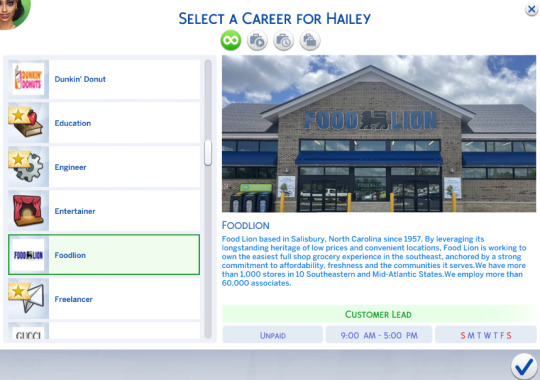
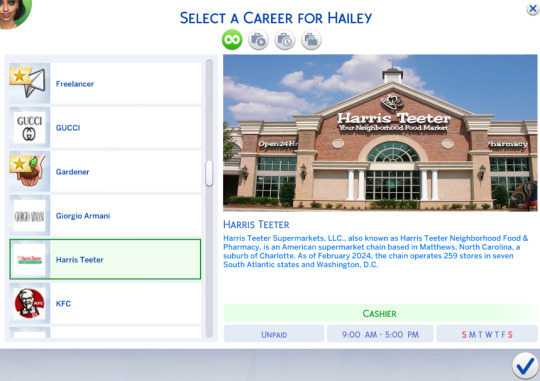


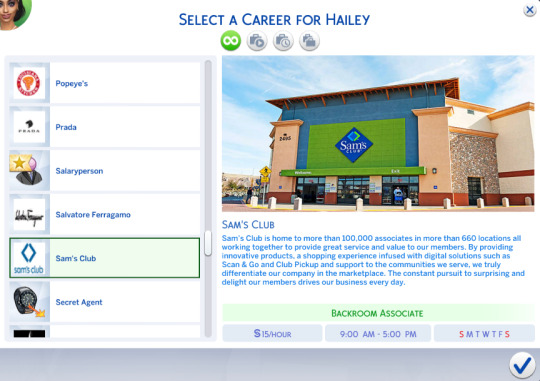
🦄The Sims 4🦄
🍉Grocery Store Bundle🍍
💕EARLY RELEASE💕
Foodlion
Food Lion based in Salisbury, North Carolina since 1957. By leveraging its longstanding heritage of low prices and convenient locations, Food Lion is working to own the easiest full shop grocery experience in the southeast, anchored by a strong commitment to affordability, freshness and the communities it serves.We have more than 1,000 stores in 10 Southeastern and Mid-Atlantic States.We employ more than 60,000 associates.
Customer Lead
Customer Service Leader
Food Lion To Go Associate
Center Store Lead
Sales Associate Cashier
Frozen Food Dairy Associate
Cake Decorator
Deli Bakery Sales Associate
Allow Teens
Allow Young Adults
Allow Adults
Allow Elders
Harris Teeter
Harris Teeter Supermarkets, LLC., also known as Harris Teeter Neighborhood Food & Pharmacy, is an American supermarket chain based in Matthews, North Carolina, a suburb of Charlotte. As of February 2024, the chain operates 259 stores in seven South Atlantic states and Washington, D.C.
Cashier
Assistant Dairy/Frozen Manager
Deli Bakery Clerk
Meat Clerk
Grocery Manager
Produce Clerk
Personal Shopper
Allow Teens
Allow Young Adults
Allow Adults
Allow Elders
Lowes Foods
Founded in 1954, Lowes Foods employs approximately 9,000 people and operates nearly 100 full-service supermarkets in North Carolina, South Carolina and Virginia. Locally owned and operated, Lowes Foods is truly a homegrown company committed to bringing community back to the table, by providing customers with the freshest and most innovative local products from local suppliers. The company maintains a strong focus on exceptional attention to our guests, with services like Lowes Foods-To-Go personal shopping and gas rewards discounts. To learn more, visit lowesfoods.com or follow Lowes Foods on Facebook or Twitter. Lowes Foods, LLC is a wholly owned subsidiary of Alex Lee, Inc.
Grocery Stocker
Personal Shopper
Deli Clerk
Bakery Clerk
Dairy/Frozen Stocker
Cake Decorator
Allow Teens
Allow Young Adults
Allow Adults
Allow Elders
Sam's Club
Sam’s Club is home to more than 100,000 associates in more than 660 locations all working together to provide great service and value to our members. By providing innovative products, a shopping experience infused with digital solutions such as Scan & Go and Club Pickup and support to the communities we serve, we truly differentiate our company in the marketplace. The constant pursuit to surprising and delight our members drives our business every day.
Backroom Associate
Cafe Associate
Team Lead
Personal Shopper
Merchandise and Stocking Associate
Freezer, Cooler and Deli Stocker Associate
Allow Teens
Allow Young Adults
Allow Adults
Allow Elders
Walmart
Walmart store managers are the best leaders in retail, and we’re investing in them – simplifying their pay structure and redesigning their bonus program, giving them the opportunity to earn an annual bonus up to 200% of their base salary.
Cashier & Front End Services
Food & Grocery
General Merchandise
Online Orderfilling & Delivery
Stocking & Unloading
Auto Care Center
Fuel Station
Health & Wellness
Allow Teens
Allow Young Adults
Allow Adults
Allow Elders
DOWNLOAD NOW
#gaming#the sims 4#the sims university#the sims 4 cc#pink#celebrities#nicki minaj#victoria secret#the sims 4 mod#sims 4 career#foodie#retail#fyp#fypシ#fypage#tumblr fyp#text post#nicki is coming#nickelodeon#female rappers#miley cyrus#kanye west#new album#latto#latto777#latte#cardi b#megan thee stallion
46 notes
·
View notes
Text
One-third of American kitchens have gas stoves—and evidence is piling up that they’re polluting homes with toxic chemicals. A study this summer found that using a single gas stove burner on high can raise levels of cancer-causing benzene above what’s been observed from secondhand smoke.
It turns out gas stoves have much more in common with cigarettes. A new investigation by NPR and the Climate Investigations Center found that the gas industry tried to downplay the health risks of gas stoves for decades, turning to many of the same public-relations tactics the tobacco industry used to cover up the risks of smoking. Gas utilities even hired some of the same PR firms and scientists that Big Tobacco did. Utilities were advised to “mount the massive, consistent, long-range public relations programs.”
Earlier this year, an investigation from DeSmog showed that the industry understood the hazards of gas appliances as far back as the 1970s and concealed what they knew from the public. The new documents fill in the details of how gas utilities and trade groups obscured the science around those health risks in an attempt to sell more gas stoves and avoid regulations—tactics still in use today.
The investigation comes amid a culture war over gas stoves. Towns across the country have passed bans on natural gas hookups in new buildings, and the federal Consumer Product Safety Commission is looking into their health hazards. The commission has said it doesn’t plan on banning gas stoves entirely after the mention of the idea sparked a backlash last December. That same month, a peer-reviewed study found that nearly 13 percent of childhood asthma cases in the United States were linked to using gas stoves. But the American Gas Association, the industry’s main lobbying group, argued that those findings were “not substantiated by sound science” and that even discussing a link to asthma was “reckless.”
It’s a strategy that goes back as far back as 1972, according to the most recent investigation. That year, the gas industry got advice from Richard Darrow, who helped manufacture controversy around the health effects of smoking as the lead for tobacco accounts at the public relations firm Hill + Knowlton. At an American Gas Association conference, Darrow told utilities they needed to respond to claims that gas appliances were polluting homes and shape the narrative around the issue before critics got the chance. Scientists were starting to discover that exposure to nitrogen dioxide—a pollutant emitted by gas stoves—was linked to respiratory illnesses. So Darrow advised utilities to “mount the massive, consistent, long-range public relations programs necessary to cope with the problems.”
The American Gas Association also hired researchers to conduct studies that appeared to be independent. They included Ralph Mitchell of Battelle Laboratories, who had also been funded by Philip Morris and the Cigar Research Council. In 1974, Mitchell’s team, using a controversial analysis technique, examined the literature on gas stoves and said they found no significant evidence that the stoves caused respiratory illness. In 1981, a paper funded by the Gas Research Institute and conducted by the consulting firm Arthur D. Little—also affiliated with Big Tobacco—surveyed the research and concluded that the evidence was “incomplete and conflicting.”
47 notes
·
View notes
Text
Police Arrested Over 100 Students at Colombia University for Peacefully Protesting
{If you all scroll to the end of this there's some articles on what to do if arrested if peacefully protesting as well as some pictures and videos from Columbia last night and today.}
Rarely do I make posts about global issues on my blog, I usually just reblog to spread support, however as someone who's currently heavily studying the Civil Rights movement for school and watching my country's law enforcement violate our civil liberties, so let's talk about something.
Firstly, a lot of Americans misunderstand how our justice system works. Firstly, in most states if you are detained without sufficient evidence you must be released after 72 hours, it's your right to a speedy trial. The prosecutor has to decide charges within 72 hours, and usually you'll be released before then if you're arrested for something like, I don't know, peacefully protesting which is kind of a right you have here? Says so in this long paper that helped found the country.
Anyways, last night, hundreds of Columbia University students were arrested for protesting in support of Gaza. The university is insisting it wasn't due to the cause the protest argued for, but the fact there was "vandalism and violence". Let's be clear on one thing: There was in fact vandalism going on, but not by a few hundred people. However, the only violence that occurred was from the NYPD, who showed up in riot gear with a military grade armoured vehicle. The police denied using tear gas but they did use flash bangs and used zip ties to arrest the protesters, who were then filed onto a bus. Sound familiar? Look up the Birmingham, AL Child Crusades during the Civil Rights Movement:

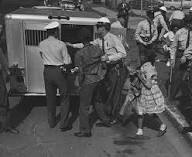
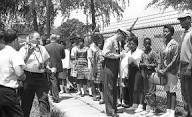
If anyone has been reading about this as well, a lot of the university officials and police are saying there were outsiders who were let into the library to assist in the protest, and that they were arrested for trespassing; Several students participating in and observing the protest have stated that this is not true and the protestors were students who were wrongfully arrested for this.
The dean of journalism at the university was also threatened with arrest if he came outside during the police arrests of the protestors; The police had no grounds to arrest this man on and were coercing him with arrest to stay inside. The police also claim their arrests of students were perfectly peaceful, while once again, both onlookers (with video and pictures) as well as students who were arrested said they used excessive force in their arrests.
Before everyone cries innocence, let me say as someone with several defense attorneys in her family that some of these students were in fact guilty of an actual crime when they began to vandalize the building. Also, there were fight outbreaks among students, however police didn't show up until after most of these fights and during said fights, stood and watched in front of the student crowd outside. (It should be mentioned, however, that these student fights were not mentioned by police or protesting/onlooking students, but students not involved in the protest and the media, so there is a chance they didn't happen at all and student injuries are from police or breaking into Hamilton Hall. It's likely the fights were not started by the protestors, but the students at Hamilton Hall as a response to the break in). However, the police had no reason to: A) Use the force and riot gear that they did. B) Threaten onlookers and staff. C) Arrest over 100 people. They didn't have reason to arrest that many people as that many people were not associated with the vandalism or trespassing, and due to the amount of people at the protest those people couldn't have been arrested for assisting in vandalism due to not even knowing about it. One of the students stated she was unaware of what was happening in most parts of the building during the protest.
The police let most of these students go pretty quickly post arrest due to: What's that? Oh yeah, lack of evidence. Either due to the amount of random arrests or because they quite literally did nothing wrong and were exercising their right to peacefully protest.
To those of you who stuck around to read this to the end: Firstly, thank you I hoped you learned something. And two, if you're planning on going to any Pro-Palestine protests, or any protests, for that matter, and you're doing so peacefully: Here's an article specifically for protest rights, and then a general article about your arrest rights in America and what to do if arrested, detained, and how to file for violation of rights or witnessing police brutality. They're very helpful and apply to all of us in America.
I'm all done rambling but here's videos and images about this if you're interested:
The Police (videos and pictures):
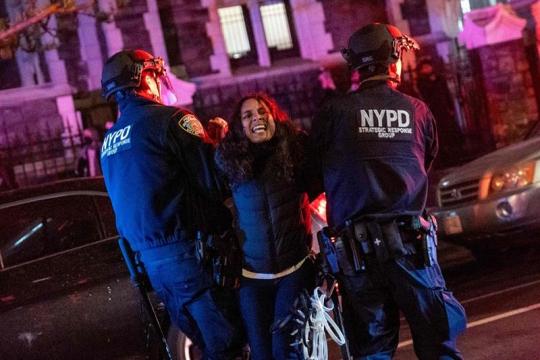

Interview from student who was threatened with arrest if they left the dorm (described injured students and showed video of a girl telling police she needed medication and was unable to get it due to being forced to stay in dorms)
Vandalism at Hamilton Hall:
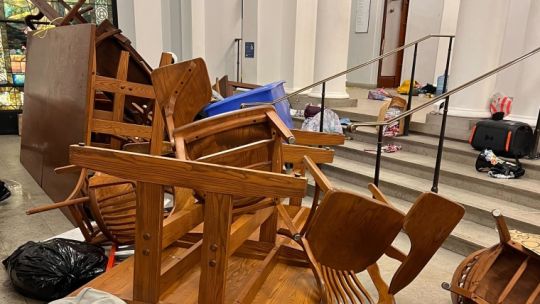
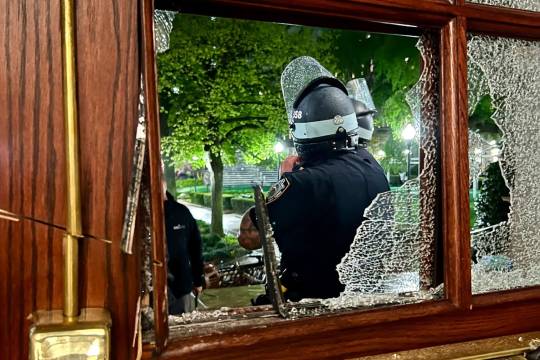
The Protestors:

Interviews from Students and Journalists about arrests and student motivation (ft. videos of arrest)
Anyways, free Palestine, that's the message, but for your own sake take a page out of MLK's book and do it as non violently as possible. That's what garners the most sympathy and makes it so you can point to the aggressor as, well, the aggressor 🇵🇸
#new lore#free gaza#gaza genocide#gaza#columbia university#columbia protest#palestine protest#global issues#palestine israel conflict#palestine information#palestine israel war#palestine genocide#police brutality#usa news#student protest#free palestine#human rights#student journalism#human rights violations#college protests#students for justice in palestine#cw violence#civil rights#know your rights#constitutional rights#america#palestine conflict#palestine will be free#palestine resistance#important lore
17 notes
·
View notes
Text
The myth that there is a humane way to execute someone who wants to live is getting harder to maintain in Alabama.
In early 2018, the state tried to execute a terminally ill man, Doyle Lee Hamm, whose veins had deteriorated from drug use and treatment for cancer and hepatitis C. Executioners, whose identities are concealed but who typically do not have medical backgrounds, repeatedly jabbed him in the legs, ankles and groin as they tried to set the IV line. They stopped only when the death warrant was close to expiring and Hamm’s groin was covered in blood.
A few weeks later, the state authorized a new execution method: death by nitrogen gas. At the time, it was purely hypothetical. Two other states allow it, but there had never been a known instance of a nitrogen execution.
That changed on Thursday, when Alabama killed 58-year-old Kenneth Smith by affixing a mask over his face and forcing him to inhale only nitrogen. He “appeared to shake and writhe on the gurney, sometimes pulling on the restraints” for at least two minutes, followed by several minutes of heavy breathing, The Associated Press reported.
“It was the most horrible thing I think I’ve ever seen,” said the Rev. Jeff Hood, Smith’s spiritual adviser, who has observed five executions in the past 13 months.
This was Smith’s second time in an execution chamber. A little more than a year ago, he spent four hours strapped to a gurney, awaiting execution as his final appeals made their way through the court system. Executioners jabbed his hands, arms and collarbone before finally calling off his lethal injection. The botched execution left him severely traumatized. He experienced nightmares, hypervigilance, hyperarousal and dissociation up until his death.
Smith’s 2022 experience was the third in a series of consecutive botched executions in Alabama.
In the lead-up to Smith’s death, his lawyers urged the courts to block the nitrogen execution, warning that Smith risked facing a slow, painful death by asphyxiation — or even surviving but in a “persistent vegetative state.”
The state attorney general’s office dismissed those concerns, claiming that nitrogen is “perhaps the most humane method of execution ever devised,” a baseless supposition undermined by the American Veterinary Medical Association’s recommendation that nitrogen not be used to euthanize most mammals. Rats who were exposed to nitrogen gas showed signs of “panic and distress” before they died, the group said.
The U.S. Supreme Court allowed the execution to proceed, with the three liberal justices dissenting.
“Twice now this Court has ignored Smith’s warning that Alabama will subject him to an unconstitutional risk of pain. The first time, Smith’s predictions came true,” Justice Sonia Sotomayor wrote in her dissent on Thursday, just before the execution. “This time, he predicts that Alabama’s protocol will cause him to suffocate and choke to death on his own vomit. I sincerely hope that he is not proven correct a second time.”
“The world is watching,” Sotomayor wrote.
Other executing states are watching, too. As states struggle to carry out lethal injections in the face of litigation and opposition from drug companies, many are looking for new ways to kill — including firing squads and even cyanide gas, the preferred killing method of Nazi Germany. That the Supreme Court allowed Alabama to evade accountability over one secretive execution method by simply switching to another will not go unnoticed in other states.
26 notes
·
View notes
Text
A biotech company in Georgia has received conditional approval from the U.S. Department of Agriculture for the first vaccine for honeybees, a move scientists say could help pave the way for controlling a range of viruses and pests that have decimated the global population. It is the first vaccine approved for any insect in the United States.
The company, Dalan Animal Health, which is based in Athens, Ga., developed a prophylactic vaccine that protects honeybees from American foulbrood, an aggressive bacterium that can spread quickly from hive to hive. Previous treatments included burning infected colonies and all of the associated equipment, or using antibiotics.
[...]
Before you start imagining a tiny syringe being inserted into a bee, the vaccine, which contains dead versions of the bacterium Paenibacillus larvae, comes in the form of food. The vaccine is incorporated into royal jelly, a sugar feed given to queen bees. Once they ingest it, the vaccine is then deposited in their ovaries, giving developing larvae immunity as they hatch.
Scientists long assumed that insects could not acquire immunity because they lacked antibodies, the proteins that help many animals’ immune systems recognize and fight bacteria and viruses. Once scientists understood that insects could indeed acquire immunity and pass it to their offspring, Dr. Freitak set about answering the question of how they did so. In 2015, she and two other researchers identified the specific protein that prompts an immune response in the offspring and realized they could cultivate immunity in a bee population with a single queen.
Their first goal was tackling American foulbrood, a bacterial disease that turns larvae dark brown and makes the hive give off a rotting smell. The disease ran rampant during the 1800s and the early 1900s in bee colonies in parts of the United States. While American foulbrood is not as destructive as Varroa mites, the bacterium can easily wipe out colonies of 60,000 bees.
[...]
Chris Hiatt, who keeps bees in North Dakota and California and is the president of the American Honey Producers Association, participated in the vaccine trial over the summer with about 800 queen bees in North Dakota.
“For beekeepers, you just don’t want to be reliant on antibiotics,” which most beekeepers give once a year or when there are flare-ups, he said. “Antibiotics can wipe out some of the beneficial microbes. This has the potential to add other things, too.”
Annette Kleiser, the chief executive of Dalan, called the vaccine “a huge breakthrough.”
“Bees are livestock and should have the same modern tools to care for them and protect them that we have for our chickens, cats, dogs and so on,” Ms. Kleiser said. [...] “When we started, there was no regulatory path,” she said. “No one has ever developed an insect vaccine — they’re wild animals who fly around,” compared to domesticated livestock and pets with vaccine protocols. She added, “We’re really hoping we’re going to change the industry now.”
213 notes
·
View notes
Text
by Jaxson Kaplan-Rudolph
If you walked a day in the shoes of a Jewish high school student, regardless of which high school, you would be shocked by the number of racist tropes or casual references and off-color jokes to atrocities that have befallen the Jewish people you would hear.
“No one asked you, you dirty Jew.”
“I bet you can hear a penny fall from a mile away.”
“Go back to the gas chambers.”
At first glance, these sentences, with varying degrees of problematic content, sound like they come from a 1930s movie, Nazi propaganda or an interview with post-2020 Kanye West.
But these are all sentences and phrases I have heard directed at me or my Jewish friends in 2023, in a place that is supposed to be an institution of higher learning. When you hear people offhandedly mention that antisemitism levels are rising in America, that does not just apply to hate crimes like those tracked by the Anti-Defamation League. It also means it is becoming more socially acceptable for people, especially teens, to revive and repeat anti-Jewish stereotypes that have been around since near the beginning of our existence as a people.
If you walked a day in the shoes of a Jewish high school student, regardless of which high school, you would be shocked by the number of racist tropes or casual references and off-color jokes to atrocities that have befallen the Jewish people you would hear. Of course, in some areas, it is worse than others; as a kid in Metro Detroit, I shudder to think of the conversations in areas of Michigan where our communities are tiny or nonexistent.
Yet, even in an area where Jews make up a substantial portion of the population, this behavior is increasingly prevalent. So, what exactly is happening in our high schools, what do Jewish students do to cope with it and how can the community help us deal with this social burden and distraction from our education?
I go to a school where students routinely have some of the best test scores in the state and often garner excellent scores on history exams. We are required to take World History and American History courses where WWII, 9-11, American slavery, the Armenian genocide and other acts of brutality are well covered, and students seem to have no problem handling the moral weight and solemn attitude associated with discussing these topics in class.
Yet, it is shocking how my peers who will gasp with outrage if someone did make jokes about these topics or did not treat them appropriately will not intervene if the same thing were to happen with quips about the Holocaust or abusive Jewish stereotypes.
I’ve seen people jokingly form a Nazi salute at a poster of Hitler in a history class or repost a “funny” meme about Jews secretly having horns and wanting to eat Christian children. Now, there is getting to be a climate where these dangerous portrayals are somehow not only deemed OK, but also humorous.
Discussing this with my Jewish friends from Monday night school and around other high schools in the area, we were not appalled, but grimly unsurprised to learn that we were all going through similar kinds of situations. Even close friends who were not Jewish might call out kids for making uncouth jokes, only to make a comment about Jews or our Jewishness in private. I won’t get into every example of stories I’ve heard, but suffice it to say that we’d all seen or heard something, directly or indirectly, that ranged from uncomfortable to horrific.
It was at least reassuring for me to talk to my friends about how we are all going through the same thing, but it’s hard to find solutions for this issue.
Besides saying “that’s not funny,” or “what the hell,” it is hard to do much without putting a target on your back, because even in the schools with the highest Jewish populations, we are firmly in the minority. The way we are able to power through this casual adversity that people don’t think causes actual harm is by sticking together.
Over the past year or so, I’ve developed a silent understanding with other Jewish kids my age who I wouldn’t normally talk to: a glance across the room, a pat on the back or a nod passing each other in the hallway. With a lot of people angrier than usual because of the current situation in the Middle East, this only becomes more important as the feeling of isolation and targeting has compounded within the last couple of weeks.
Since many of our peers began to mercilessly attack Israel and Israelis after the reignition of the conflict and speak to us as if we are representatives of the Israeli government, remembering the words “Hinei ma tov, umah na’im, shevet achim gam yachad” (“How good and how pleasant it is that brothers dwell together.”) becomes more important than ever.
Even if we are treated like outsiders, whether we are religious or not, we must stick together with our tribe and treat everyone with harmony and respect, no matter what they say back to us.
The way the adult Jewish community can help us deal with this struggle is to do the confronting when we feel socially like we cannot. Parents, temples and Jewish organizations should be actively supporting and asking their high school kids if they need to share anything, because chances are, they probably do.
Problems obviously need to be worked out on a case-by-case basis, but most of the time it’s not the fault of a specific person or a few people; it’s a problem with the atmosphere or culture of the school or group.
Most Jewish kids I know are strong, motivated and intelligent, but it can be too much to ask for everyone to plan their own initiatives and reach out to create things like antisemitism seminars and panel discussions that help heal. What could be beneficial is if groups and congregations can provide opportunities to students that seem interested but aren’t sure how to take the first step to healing.
The next time you see a Jewish high school student you know, do not apologize or act super worried about what they’re probably going through now. But please offer them support to work toward the Jewish concept more important now than ever: tikkun olam, healing the world.
Jaxson Kaplan-Rudolph is a junior at a Metro Detroit public high school.
28 notes
·
View notes
Note
Which are the preferred personal vehicles of 47, Diana, Lucas and Olivia?
I know that 47 has access to the hearse in Freelancer and while that is his brand of humor, I don't see him using it much.
I bet Lucas had a bike he drove recklessly after he escaped from the institute (misquoting B99's Hitchcock, he has nothing left to live for and drives like it). But after he got Olivia, he upgraded to a car. But I can't decide if it's funnier if he goes directly to a football mom suv or if he drives something like a muscle car and only when someone makes an offhand comment on its safety, he switches to the suv. (Hi Mr Grey. Olivia is settling in nicely. Is it true you drove her in an Impala? My husband has one as his project car and those safety ratings are terrible, I would never pick up my kids in one. .......Haha, of coirse I wouldn't either, my car's at the garage nd this is just a rental........fuck).
Diana probably has a landrover, reinforced like a small tank.
I bet Olivia drives a cute hybrid or electrical car.
47.....sleek Italian sports car? In black, of course.
oh boy how I LOVE that question! Honestly, I've been thinking about that quite a lot recently, I don't even know why, but it crossed my mind
And I like your headcanon, which I absolutely agree with! They probably all have several cars, they are rich, they can drive whatever they want. But there are one or two cars that I associate with them…
I think 47 loves cars, especially old cars. He certainly has a penchant for spending his money on classics.
But an everyday car? Next to his many sports cars (e.g. Lamborghini Aventador)? Probably a rich (old) person one like a Porsche Panamera (in red because it's probably his favourite colour, I mean his tie is always red):


But I think he prefers to drive his classics. Unfortunately I don't know much about them, but he seems to love this black one in Freelancer a lot!
I can well imagine Diana in a sleek little sports car. She certainly has to get around a lot and quickly. Power woman style (but still reinforced like a small tank, as you say. She knows her enemies and how to protect herself from them).
I think Diana has a lead foot on the highway (that's what we say in Germany when you drive way too fast)
So why not an Audi R8 in blue? Her little show-off car


47 loves driving in it. But not so much when Diana is at the wheel (vroom vroom)
Ohhh Olivia, our cute little mouse, must have been driving around in a junk car for many years. But she values environmental protection, so she got herself a small, affordable electric car recently (after the old car died). Everyone thinks the car is ugly, but she loves her green box a lot, her Honda e:


(this car is so ugly, it's insane)
And Lucas. Oh, he probably sees cars purely as a commodity. And yes, he certainly made sure to drive a decent car in Olivia's school days so that no one would be suspicious, but I think he has several cars (despite being against capitalism).
One for missions, where you get a lot in, get through every terrain, etc., probably a Dodge Ram 1500:


(I don't know much about American cars, but here in Europe these things are way too big for our streets and are more used by hunters or forestry workers because you can pack a lot onto the loading area)
He probably has a small SUV for everyday use (in the city), because the weapons have to go somewhere, right? A Dacia Duster is probably something for him - relatively cheap, yet robust, not a posh car, just an SUV:


(I'm starting to get the feeling that I am going to sell you a few cars)
BUT in the depths of his garage in Berlin he has his greatest treasure, his old Opel Corsa B in mint green:
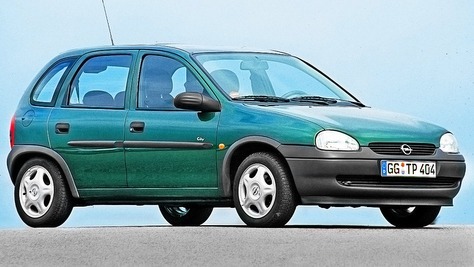

This thing has seen a lot and is 30 years old. All doors except the driver's door can only be opened from the inside, the boot can no longer be locked properly and when you hit the gas pedal, the car only gets louder and not faster. Air conditioning: Roll down the windows manually.
But he loves it with all his heart and enjoys driving around Berlin at weekends to get a Döner at his favourite Döner stand 💘
(47 only drives with Lucas in absolute emergencies in this car, which sometimes makes strange noises and the lack of insulation makes it feel like your arse is about to hit the road. 140 km/h (around 85 mph) with this car is like a death sentence, but Lucas has fun)
#Hitman aks#as you can see I mostly know European cars I'm sorry#but since Lucas (in my mind) lived in Berlin for a few years he can drive a German car#and for me 47 is a bit of a boomer when it comes to cars#only mums who drop their kids off at kindergarten or old men drive porsches here lmao#fun fact: a friend of mine still drives a 1993 opel corsa in mint green and it's an adventure every time#will we get to our destination or will the car give up before then? Who knows#my friend drives 140 on the autobahn regardless of the sounds it makes#and i love it
17 notes
·
View notes